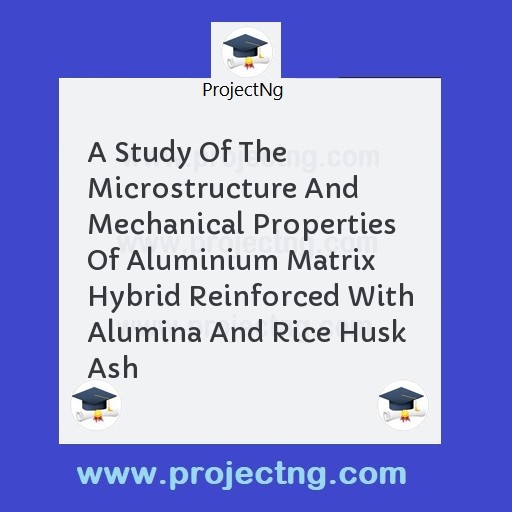A Study Of The Microstructure And Mechanical Properties Of Aluminium Matrix Hybrid Reinforced With Alumina And Rice Husk Ash
Cooperative Economics Project Topics
Get the Complete Project Materials Now! »
A STUDY OF THE MICROSTRUCTURE AND MECHANICAL PROPERTIES OF ALUMINIUM MATRIX HYBRID REINFORCED WITH ALUMINA AND RICE HUSK ASH
A STUDY OF THE MICROSTRUCTURE AND MECHANICAL PROPERTIES OF ALUMINIUM MATRIX HYBRID REINFORCED WITH ALUMINA AND RICE HUSK ASH CHAPTER ONE
1.0 INTRODUCTION
Aluminium matrix composites (AMCs) are noted for their unique combination of mechanical, physical and chemical properties which are scarcely attainable with the use of monolithic materials (Behera, 2013). This has made AMCs a strong competitor to steel in terms of versatility for use in a wide range of engineering applications. AMCs are currently applied in the design of components for automobiles, aircrafts, marine structures and facilities, defence assemblies, sports and recreation among many others (Chabra etal,2012). Other notable advantages of AMCs are the relatively low cost of processing of [in comparison to other matrices types such as Magnesium (Mg), Copper (Cu), Titanium (Ti), Zinc (Zn)]; and its amenability to production utilizing processing techniques applied for the production of conventional monolithic metallic alloys (such as casting and powder metallurgy). Currently, the design of high performance aluminium based composites at significantly reduced cost is receiving much attention from materials researchers (Devi etal,2011). This is discernible from the dominant use of stir casting by most researchers from developing countries; and the sustained interest in the consideration of industrial and agro wastes as reinforcements in AMCs. Agro waste ashes obtained by the controlled burning of agro waste products such as baggasse, bamboo leaf, coconut shell, groundnut shell, and rice husk among others; have the advantages of low densities and processing cost compared with common synthetic reinforcing ceramics such as silicon carbide and alumina. The agro waste ashes have been successfully utilized to produce Al matrix composites with property levels which can be improved with the complement of synthetic reinforcements such as silicon carbide and alumina (Dunia, 2011).
The design concept is built on harnessing the high strength and wear capabilities of notable synthetic reinforcements such as silicon carbide and alumina with the light weight and low cost of processing of agro waste ashes. There are very few literatures which have considered the design of AMCs with the use of hybrid reinforcements of synthetic technical ceramics and agro waste ashes. The mechanical properties of some of these low cost Al matrix composites have been reported to be encouraging depending on the weight ratio between the synthetic reinforcement and the agro waste ashes selected. The corrosion and wear properties of these Al matrix hybrid composites are yet to receive any notable attention considering available literatures. Corrosion and wear are very important scientific phenomena requiring consideration in composite materials design to ensure material reliability in applications where they come in contact with the AMCs is widely acclaimed for its inconclusiveness judging from the often contradicting findings reported by authors for the same MMC system (Pratik and Awate, 2013). Thus it is very unlikely for the corrosion behaviour of newly developed AMCs to be predicted without subjecting them to experimental studies. The wear properties of AMCs have been reported to be dependent on factors such as the nature, size, and volume percent of the reinforcing particles. Investigations on the wear behaviour of Al matrix hybrid composites produced with the use of agro waste ashes as complementing reinforcement are quite limited in literature. This work is an effort to understand the corrosion and wear behaviour of Al matrix composites developed using rice husk ash (RHA) and alumina as reinforcement.
1.1 AIM AND OBJECTIVES OF THE STUDY
1.1.1 AIMS
The aim of this seminar report is to present a study on microstructure and mechanical properties of aluminum matrix hybrid reinforced with alumina and rice husk ash.
1.1.2 OBJECTIVES
The specific objectives of the seminar are as follows;
1. To investigate the microstructure of aluminium matrix hybrid reinforced with alumina and rice husk ash.
2. To examine the mechanical properties of aluminium matrix hybrid reinforced with alumina and rice husk ash.
3. To understand the microstructure and mechanical properties of Al matrix composites developed using rice husk ash (RHA) and alumina as reinforcement
Be the First to Share On Social

Enjoying our content?
Don't miss out on new videos! Subscribe to our YouTube channel for more awesome content.
Subscribe Now!













